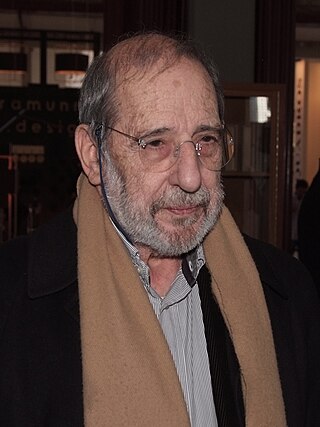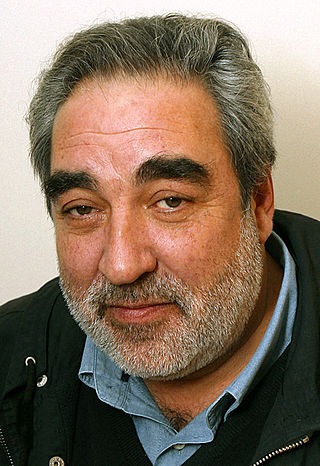
Daniel Libeskind is a Polish-American architect, artist, professor and set designer. Libeskind founded Studio Daniel Libeskind in 1989 with his wife, Nina, and is its principal design architect.

Álvaro Joaquim de Melo Siza Vieira is a Portuguese architect, and architectural educator. He is internationally known as Álvaro Siza and in Portugal as Siza Vieira.

The Serpentine Galleries are two contemporary art galleries in Kensington Gardens, Westminster, Greater London. Recently rebranded to just Serpentine, the organisation is split across Serpentine South, previously known as the Serpentine Gallery, and Serpentine North, previously known as the Sackler Gallery. The gallery spaces are within five minutes' walk of each other, linked by the bridge over the Serpentine Lake from which the galleries get their names. Their exhibitions, architecture, education and public programmes attract up to 1.2 million visitors a year. Admission to both galleries is free. The CEO is Bettina Korek, and the artistic director Hans Ulrich Obrist.

Charles Alexander Jencks was an American cultural theorist, landscape designer, architectural historian, and co-founder of the Maggie's Cancer Care Centres. He published over thirty books and became famous in the 1980s as a theorist of postmodernism. Jencks devoted time to landform architecture, especially in Scotland. These landscapes include the Garden of Cosmic Speculation and earthworks at Jupiter Artland outside Edinburgh. His continuing project Crawick Multiverse, commissioned by the Duke of Buccleuch, opened in 2015 near Sanquhar.
Arup is a British multinational professional services firm headquartered in London that provides design, engineering, architecture, planning, and advisory services across every aspect of the built environment. It employs about 17,000 people in over 90 offices across 35 countries, and has participated in projects in over 160 countries.
Starchitect is a portmanteau used to describe architects whose celebrity and critical acclaim have transformed them into idols of the architecture world and may even have given them some degree of fame among the general public. Celebrity status is generally associated with avant-gardist novelty. Developers around the world have proven eager to sign up "top talent" (i.e., starchitects) in hopes of convincing reluctant municipalities to approve large developments, of obtaining financing or of increasing the value of their buildings. A key characteristic is that the starchitecture is almost always "iconic" and highly visible within the site or context. As the status is dependent on current visibility in the media, fading media status implies that architects lose "starchitect" status—hence a list can be drawn up of former "starchitects".
Venice Biennale of Architecture is an international exhibition of architecture from nations around the world, held in Venice, Italy, every other year. It was held on even years until 2018, but 2020 was postponed to 2021 due to the COVID-19 pandemic shifting the calendar to uneven years. It is the architecture section under the overall Venice Biennale and was officially established in 1980, even though architecture had been a part of the Venice Art Biennale since 1968.

Sir Anish Mikhail Kapoor, is a British-Indian sculptor specializing in installation art and conceptual art. Born in Mumbai, Kapoor attended the elite all-boys Indian boarding school The Doon School, before moving to the UK to begin his art training at Hornsey College of Art and, later, Chelsea School of Art and Design.

Eduardo Elísio Machado Souto de Moura, better known as Eduardo Souto de Moura, is a Portuguese architect who was the recipient of the Pritzker Architecture Prize in 2011 and the Wolf Prize in Arts in 2013. Along with Fernando Távora and Álvaro Siza, he is one of the alumni of the Porto School of Architecture, where he was appointed a Professor.
Fernando Luís Cardoso de Meneses de Tavares e Távora, ComSE, simply known as Fernando Távora, was a renowned Portuguese architect and professor.
Tony Fretton is a British architect known for his residential and public gallery buildings, as well as other British and international design work. He graduated from the Architectural Association (AA) and worked for various practices including Arup, Neyland and Ungless, and Chapman Taylor, before setting up his own firm, Tony Fretton Architects, in 1982. His first major project was the Lisson Gallery in 1990. He is known for designing "location sensitive art spaces" using a combination of vernacular and minimalist approaches balancing new and age-old designs.

The ArcelorMittal Orbit is a 114.5-metre (376-foot) sculpture and observation tower in the Queen Elizabeth Olympic Park in Stratford, London. It is Britain's largest piece of public art, and is intended to be a permanent lasting legacy of London's hosting of the 2012 Summer Olympic and Paralympic Games, assisting in the post-Olympics regeneration of the Stratford area. Sited between the Olympic Stadium and the Aquatics Centre, it allows visitors to view the whole Olympic Park from two observation platforms.
The Weave Bridge is a 145 ft (44 m) bridge at the University of Pennsylvania, USA, which was conceptualized by Cecil Balmond and engineered by Ammann & Whitney. It was commissioned by the university in 2007, and opened in June 2009.
The Ito-Balmond Serpentine Pavilion is a structure designed by Cecil Balmond and Toyo Ito and originally built for the Serpentine Gallery Pavilion programme in London's Kensington Gardens, Hyde Park, in 2002 and now part of a restaurant in southern France. It focuses on modern and contemporary art. Each year the Serpentine Gallery builds a temporary structure for the summer in its grounds, and projects are led by director Julia Peyton-Jones. The Ito-Balmond Serpentine Pavilion has been hailed as one of the most successful temporary pavilions to date. Jonathan Glancey, architecture critic for the UK's The Guardian, called it "one of the most exquisite and revolutionary buildings of recent times." The design is based on an algorithm designed by Balmond. "Although fun to look at, this structure was rooted in complex geometry…the pavilion had no façade and no hidden structural frame behind it… what you saw was 100% pure structure, its holistic beauty like that of a crystal or a snowflake." Balmond was awarded the Gengo Matsui Prize for the pavilion, one of the highest awards for engineering given in Japan. The pavilion now serves as the beach club restaurant of a luxury hotel in Le Beauvallon, across the bay from Saint-Tropez in southern France. Ito and Balmond have since collaborated on the Taichung Opera House in Taiwan.
Jannuzzi Smith is a design studio founded in 1993 by Michele Jannuzzi (1967) and Richard Smith (1967) in London. They now have offices in London and Lugano, Switzerland.
Marsyas is a 150-meter-long, ten storey high sculpture designed by Anish Kapoor and Cecil Balmond. It was on show at Tate Modern gallery, London in 2003 and was commissioned as part of the Unilever Series. Marsyas was the third in a series of commissions for Tate Modern's Turbine Hall and the first to make use of the entire space.
The year 2011 in architecture involved some significant architectural events and new buildings.
The Faculty of Architecture and Arts at the Lusíada University of Porto is a private institution that offers undergraduate and postgraduate studies in architecture and design. Located in Porto, Portugal, FAAULP belongs to the Lusíada University of Porto.
The year 2012 in architecture involved some significant architectural events and new buildings.

The Porto School is a movement of modern and contemporary architecture in Portugal. Grounded in the teaching at the Porto School of Fine Arts and the Porto School of Architecture, it is one of the most influential architectural movements in the history of Portuguese architecture. Its main figures, Fernando Távora, Álvaro Siza Vieira, and Eduardo Souto de Moura are some of the most globally renowned Portuguese architects.











